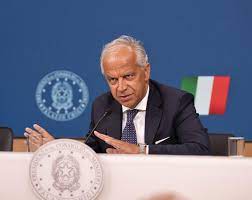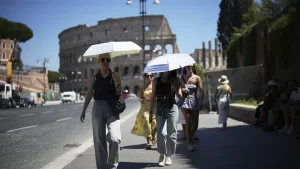Italy says increase in migrant arrivals worrisome but numbers ‘to drop’

Rome: The Italian government has noted that, despite a surge in migrant arrivals, the trend is downward and that a permanent committee has been established that will deal with the matter. The interior minister praised collaboration with Tunisia and regions.
Migrant arrivals to Italy have doubled, but the trend is decreasing, the government said this week.
At the end of a cabinet meeting and one of the Interministerial Committee for Security, the government took stock of the migration “emergency” that the country is experiencing and attempted to clarify what the figures released mean.
“There is an undeniable fact about migrants: since the beginning of the year to Aug. 28, a 103% increase was seen in arrivals via sea compared with the same period of last year,” Undersecretary to the Presidency Alfredo Mantovano said.
However the “numbers should be interpreted”, he added. Despite the fact that these numbers “are objectively worrisome, they cannot but show the dynamics of the arrivals themselves, which reached a peak in the month of May and then decreased,” Mantovano said.
For comparison: In May, recorded arrivals from Tunisia were +1008% compared to last year. Now they are +386%. On the Libya route, the rise was +167% in May and is now +13%, the undersecretary explained.
Italy’s interior minister Matteo Piantedosi has said that these numbers give hope.
“We have over the course of the year seen an increase of 329% in migrant arrivals, a figure that has dropped to 103%. This shows that there has been a drop in the growth curve and we find this encouraging.”
He claimed that collaboration with Tunisia has kept people from departing — “43,000 people,” he said, “+171% compared with the previous year. The work that Tunisia has done is important,” he added.
The minister announced that “there will be constant contact with the government [the reference is to the meetings of the Interministerial Committee for Security of the Republic, which starting in late August will become regular, Ed.] and we will continue in this direction even though the numbers are still very significant including as concerns reception.”
This summer of record-high migrant arrivals has meanwhile reached a new peak.
On August 26, when 55 boats arrived, some 3,042 migrants were recorded as arriving in Italian territory via sea. This was the highest number in 2023, while in the same period of last year there had been 443 migrants.
Lampedusa, which had in these days seen over 4,300 migrant presences at the same time, continues to suffer overcrowding despite ceaseless transfers.
There are another 818 migrants in the disembarking and pre-identification are of Porto Empedocle in the Sicilian city of Agrigento.
At the Naples port, 254 migrants have disembarked from the Ocean Viking NGO humanitarian rescue ship, including 37 unaccompanied minors.
After an alarm launched by the National Association of Italian Municipalities (ANCI) some days ago, the latest warning has come from Turin mayor Stefano Lo Russo.
“It is useless to deny it, the situation is certainly very complicated even here. Turin is helping out with this type of politics but it is clear that over the long term it is unsustainable. It is an issue on which,” he added, “it is necessary to open direct talks with the government. In part because the relationship with prefects, who do very important work, is one of collaboration but over time cannot last. It is necessary to imagine different ways,” Lo Russo said.
The Italian interior minister meanwhile assured the mayor of Italy’s northeastern city Trieste that 200 migrants will be sent away from the city.
The governor of the Friuli region and the president of the Conference of the Regions, Massimiliano Fedriga, also commented on the emergency.
“Hotspots are a bandaid and not a solution. However, I prefer a hotspot — which at least takes people away from the territory — to widespread reception,” he said.
On the issue of reception, Lombardy is the region with the largest presence of migrants, followed by Emilia Romagna, Sicily (on which the presence of hotspots weighs), Piedmont, Lazio and Campania, Tuscany, Veneto, and Puglia. This was shown by statistics provided every 15 days by the government. The latest date released was on August 15.
There are 13,724 migrants in the Lombardy region in reception centers and 3,090 in integration and reception centers (SAI), for a total of 16,814.
In the Emilia Romagna region there are 9,387 and 3,185 respectively, for a total of 12,572.
There are over 10,000 migrants in the Lazio and Campania regions of the country as well.
As of July 31, Sicily was the region with the largest number of migrants in SAI centers: 5,332.
Overall, the total number of migrants received in the country mid-month was 132,796, including 34,761 through the SAI system.
At the political level, the government is preparing to introduce a security decree in September with new measures to speed up the repatriation of irregular migrants who have engaged in violent or dangerous behaviours, possibly through providing more powers to prefects and police superintendents.
The government also plans to build more repatriation centers, while existing ones will have their functions fully restored.





